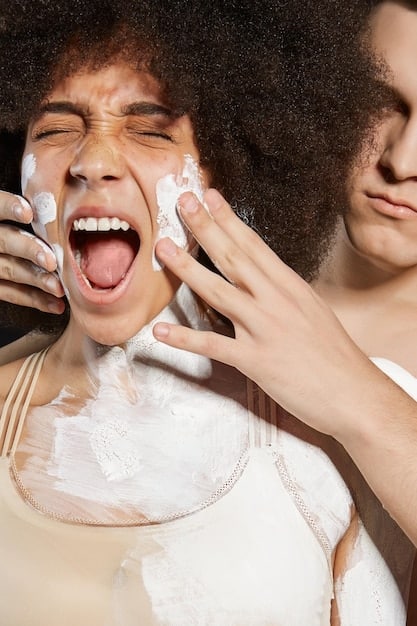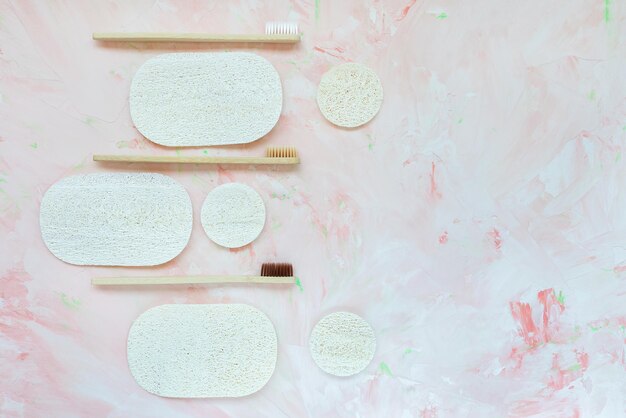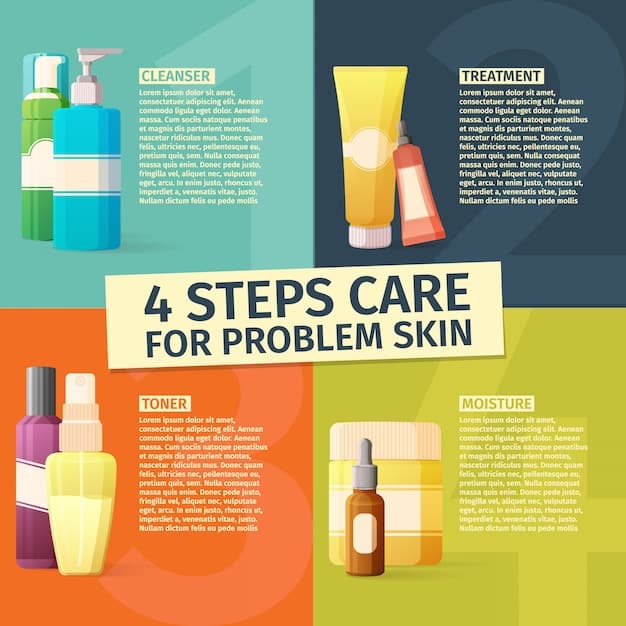Skincare Routine Mistakes: Quick Fixes for Flawless Skin

Skincare routine mistakes can sabotage your efforts for a healthy complexion; however, adopting simple changes in product application and technique can lead to significant improvements in your skin’s appearance in less than 10 minutes.
Are you unintentionally sabotaging your skincare efforts? Many common skincare routine mistakes can prevent you from achieving that flawless complexion you desire. The good news is that these errors are easily fixable, often in under 10 minutes, leading to healthier, more radiant skin.
Common Cleansing Mistakes and How to Correct Them
Cleansing is the foundation of any good skincare routine, but it’s easy to make mistakes that can strip your skin of its natural oils or leave behind residue. Understanding these pitfalls is the first step toward a healthier, more balanced complexion.
Using the Wrong Cleanser Type
Selecting the right cleanser for your skin type is crucial. A cleanser that’s too harsh can lead to dryness and irritation, while one that’s too gentle might not effectively remove dirt and makeup.
Rushing the Cleansing Process
Proper cleansing requires time and attention. Rushing through the process can leave behind impurities that clog pores and lead to breakouts.
- Solution 1: Choose a cleanser formulated for your skin type – oily, dry, combination, or sensitive.
- Solution 2: Massage the cleanser onto your skin for at least 60 seconds to allow it to properly dissolve dirt and oil.
- Solution 3: Rinse thoroughly with lukewarm water to remove all traces of the cleanser.
By taking the time to choose the right cleanser and cleanse properly, you can ensure that your skin is clean, balanced, and ready for the next steps in your skincare routine. A mindful approach to cleansing is a simple yet effective way to improve the health and appearance of your skin.
Exfoliation Oversights and Simple Solutions
Exfoliation is essential for removing dead skin cells and revealing a brighter complexion. However, over-exfoliating or using the wrong techniques can damage your skin’s protective barrier.

Knowing how to properly exfoliate is crucial for achieving healthy, glowing skin without causing irritation or damage.
Over-Exfoliating Your Skin
Exfoliating too frequently can strip your skin of its natural oils, leading to dryness, irritation, and even inflammation.
Using Harsh Exfoliants
Scrubs with large, abrasive particles or chemical exfoliants with high concentrations of acids can be too harsh for sensitive skin.
- Solution 1: Exfoliate 1-2 times per week, depending on your skin type and sensitivity.
- Solution 2: Choose gentle exfoliants with fine, rounded particles or chemical exfoliants with lower concentrations of acids.
- Solution 3: Pay attention to your skin’s reaction and adjust the frequency and intensity of exfoliation accordingly.
Mastering the art of exfoliation involves finding the right balance between removing dead skin cells and protecting your skin’s delicate barrier. Gentle exfoliation promotes cell turnover, leading to smoother, brighter, and healthier skin.
Toner Application Errors: Maximizing Absorption
Toners can help balance your skin’s pH levels and prepare it for the absorption of serums and moisturizers. However, improper application can limit their effectiveness.
Using a toner effectively makes a noticeable difference in how well your skin absorbs subsequent products.
Applying Toner on Dry Skin
Applying toner on dry skin can actually draw moisture away from your skin, leaving it feeling tight and dehydrated.
Using the Wrong Type of Toner
Toners containing alcohol can be too drying for some skin types, while those with fragrances or dyes can cause irritation.
- Solution 1: Apply toner to damp skin after cleansing to help lock in moisture.
- Solution 2: Choose toners that are alcohol-free and formulated with hydrating ingredients like hyaluronic acid or glycerin.
- Solution 3: Pat the toner gently onto your skin instead of rubbing it in to avoid irritation.
Using toner correctly can significantly enhance your skincare routine, ensuring your skin remains hydrated and receptive to other products. The key is to apply it on damp skin with a toner that complements your skin type, facilitating better absorption and overall skin health.
Serum Selection and layering Snafus
Serums are potent treatments that can address specific skin concerns. However, using the wrong serums or layering them incorrectly can diminish their benefits.
Effective serum use is vital for anyone serious about targeted skincare. The right choice and layering can dramatically improve skin health.
Mismatching Serums to Skin Needs
Using a serum that doesn’t address your specific skin concerns can be a waste of time and money.
Layering Serums in the Wrong Order
Applying thicker serums before thinner ones can prevent the thinner serums from penetrating the skin effectively.
- Solution 1: Choose serums that target your specific skin concerns, such as acne, hyperpigmentation, or aging.
- Solution 2: Apply serums in order from thinnest to thickest to ensure proper absorption.
- Solution 3: Allow each serum to fully absorb into your skin before applying the next one.
Proper selection and layering of serums ensure that each ingredient reaches its intended target within the skin, maximizing the potential benefits. Understanding your skin’s specific needs and the correct order of application transform your skincare routine into a highly effective process.
Moisturizing Mishaps and Hydration Hacks
Moisturizing is crucial for keeping your skin hydrated and preventing dryness. However, using the wrong moisturizer or applying it incorrectly can hinder its effectiveness.

Moisturization is a cornerstone of healthy skin, and doing it right involves more than just slapping on any cream.
Skipping Moisturizer Altogether
Even oily skin needs moisturizer to maintain its hydration levels and prevent overproduction of oil.
Applying Moisturizer to Dry Skin
Applying moisturizer to dry skin can trap dryness and prevent the moisturizer from properly hydrating the skin.
- Solution 1: Choose a moisturizer that is appropriate for your skin type – lightweight for oily skin, richer for dry skin.
- Solution 2: Apply moisturizer to damp skin after cleansing and toning to help lock in moisture.
- Solution 3: Gently massage the moisturizer into your skin until it is fully absorbed.
Adopting these hydration hacks can lead to supple, well-nourished skin, making your complexion look and feel healthier. Proper application and the right moisturizer for your skin type are simple tweaks that can yield substantial benefits.
Sunscreen Slip-Ups: Ensuring Full Protection
Sunscreen is the most important step in any skincare routine, but many people make mistakes that compromise its effectiveness.
Sunscreen is your best defense against premature aging and skin cancer, but its effectiveness hinges on correct application.
Not Applying Enough Sunscreen
Most people only apply 25-50% of the recommended amount of sunscreen, leaving their skin vulnerable to sun damage.
Forgetting to Reapply Sunscreen
Sunscreen needs to be reapplied every two hours, especially after swimming or sweating, to maintain its protective effect.
- Solution 1: Apply at least a shot glass-sized amount of sunscreen to your entire body, including often-forgotten areas like your ears, neck, and hands.
- Solution 2: Reapply sunscreen every two hours, or more frequently if you are swimming or sweating.
- Solution 3: Choose a broad-spectrum sunscreen with an SPF of 30 or higher to protect against both UVA and UVB rays.
Consistently adhering to these guidelines ensures your skin is well-protected from the harmful effects of the sun. Proper sunscreen usage goes beyond just application; it requires diligence and awareness, contributing significantly to long-term skin health.
Nighttime Routine Neglect: Repair and Rejuvenate
Your nighttime skincare routine is crucial for repairing and rejuvenating your skin while you sleep. Neglecting this step can slow down the skin’s natural healing process.
Maximizing the nighttime routine is crucial for skin repair, as it’s when your skin is most receptive to treatments.
Skipping Nighttime Cleansing
Going to bed with makeup and dirt on your skin can clog pores and lead to breakouts.
Ignoring Targeted Treatments
Nighttime is the perfect time to use targeted treatments like retinoids or exfoliating acids to address specific skin concerns.
- Solution 1: Always cleanse your skin thoroughly before bed to remove makeup, dirt, and oil.
- Solution 2: Incorporate targeted treatments into your nighttime routine to address specific skin concerns.
- Solution 3: Use a richer moisturizer at night to help repair and hydrate your skin while you sleep.
Embracing a dedicated nighttime skincare routine can lead to transformative results, leveraging the skin’s natural overnight repair processes for a healthier, more radiant complexion. Properly preparing and treating your skin before bed makes a significant difference in its overall health and appearance.
| Key Point | Brief Description |
|---|---|
| 🧼 Cleansing | Use the right cleanser for your skin type and cleanse for at least 60 seconds. |
| 🧽 Exfoliation | Exfoliate gently 1-2 times a week to avoid irritation. |
| 🧴 Moisturizing | Apply moisturizer to damp skin to lock in hydration. |
| ☀️ Sunscreen | Apply generously and reapply every two hours, especially after swimming. |
Frequently Asked Questions
▼
Exfoliate 1-2 times per week, adjusting based on your skin’s sensitivity. Over-exfoliating can lead to irritation and dryness, so it’s crucial to monitor how your skin reacts and adjust accordingly.
▼
Not always; while some products work well day and night, others are better suited for specific times. For instance, sunscreen is essential for daytime, while retinoids are best applied at night due to sun sensitivity.
▼
Apply at least a shot glass-sized amount for your entire body. Ensure all exposed areas, including the ears, neck, and hands, are covered, as these are often overlooked but equally susceptible to sun damage.
▼
Apply products from thinnest to thickest. Start with cleansers, then toners, serums, moisturizers, and finally, sunscreen during the day to ensure proper absorption and effectiveness of each product.
▼
Stop using the product immediately. Introduce new products one at a time to identify the culprit. If irritation persists, consult a dermatologist for professional advice and personalized solutions.
Conclusion
By addressing these common skincare routine mistakes and implementing the quick fixes outlined, you can significantly improve your skin’s health and radiance. Remember, consistency and attention to detail are key to achieving your skincare goals.





